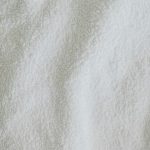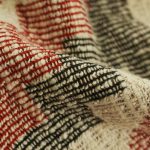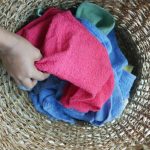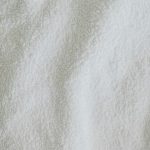You might be surprised to learn that the right kitchen linens can greatly impact your cooking and cleaning efficiency. Many overlook the importance of fabric absorbency and stain release when choosing towels and cloths. Understanding these qualities can transform your kitchen experience. So, what are the best fabrics to take into account for ideal performance? Let’s explore the top choices that can enhance both functionality and hygiene in your kitchen.
Table of Contents
Key Takeaways
- Bamboo and microfiber are top choices for kitchen linens due to their exceptional absorbency and quick moisture absorption capabilities.
- Cotton and terry cloth offer excellent absorbency while being soft, durable, and suitable for a variety of kitchen tasks.
- Waffle weave fabrics enhance moisture retention and have quick-drying properties, making them ideal for reducing odors and maintaining freshness.
- Wash kitchen linens in cold water and avoid fabric softeners to preserve absorbency and fabric integrity over time.
- For effective stain release, act quickly and use appropriate techniques like blotting and specific stain removers for different types of stains.
Understanding Absorbency in Kitchen Linens
When it comes to kitchen linens, absorbency is key. You want your towels and cloths to soak up spills and messes efficiently, guaranteeing your kitchen stays clean and dry. High absorbency means less time wrestling with damp linens and more time enjoying your culinary creations.
The right kitchen linens should quickly wick moisture away, making them essential for tasks like drying dishes or wiping countertops. You’ll find that absorbent fabrics help prevent the spread of bacteria, keeping your cooking space hygienic.
Plus, they reduce the hassle of frequent laundry trips. Understanding absorbency guarantees you choose kitchen linens that truly meet your needs, enhancing both functionality and cleanliness in your kitchen routine.
Top Fabrics for High Absorbency
Many homeowners often overlook the importance of fabric choice when it comes to kitchen linens, yet the right materials can make a significant difference in absorbency. If you want effective kitchen linens, consider these top fabrics known for their high absorbency:
| Fabric Type | Absorbency Level | Ideal Use |
|---|---|---|
| Bamboo | High | Dish towels |
| Microfiber | Very High | Cleaning cloths |
| Linen | Moderate | Table napkins |
Bamboo is not only eco-friendly but also absorbs moisture quickly, while microfiber excels at trapping spills. Linen, though less absorbent, offers great durability and a stylish look. Choosing the right fabric is essential for keeping your kitchen efficient and tidy.
Cotton: The Classic Choice
Cotton is often regarded as the go-to fabric for kitchen linens, and for good reason. Its natural fibers provide excellent absorbency, making it perfect for dish towels and aprons. You’ll find that cotton quickly soaks up spills and dries quickly, ensuring your kitchen stays tidy.
Plus, it’s soft against your skin, which is a must when you’re spending hours cooking or cleaning.
Another advantage is cotton’s versatility; it comes in various patterns and colors, allowing you to match your kitchen decor effortlessly.
When it comes to washing, cotton is easy to care for and holds up well against stains. You can confidently toss it in the laundry, knowing it’ll maintain its quality.
Terry Cloth: Plush and Effective
When you’re looking for kitchen linens, terry cloth stands out for its high absorbency.
Its soft and durable texture makes it perfect for a variety of cleaning tasks.
Whether you’re drying dishes or wiping spills, terry cloth is versatile and effective.
High Absorbency Characteristics
Terry cloth stands out among kitchen linens for its exceptional absorbency, making it a top choice for anyone who needs reliable drying and cleaning materials. When you choose terry cloth, you’re opting for a fabric that excels in soaking up moisture efficiently.
Here are some key characteristics that enhance its appeal:
- Thick loops: These create more surface area, allowing for maximum liquid absorption.
- Quick drying: After use, terry cloth tends to dry faster than many other fabrics, reducing mildew risks.
- Versatile use: Whether drying dishes or wiping spills, its absorbency makes it suitable for any kitchen task.
- Durable performance: It holds up well through numerous washes without losing its absorbent qualities.
With terry cloth, you’ll always have a dependable kitchen companion.
Soft and Durable Texture
While you want your kitchen linens to be absorbent, they also need to feel soft and durable against your skin. Terry cloth is an excellent choice for this purpose.
Its plush texture not only provides comfort but also enhances its absorbency, making it perfect for drying dishes or wiping spills. You’ll appreciate how gentle it feels while still being robust enough to handle daily use.
Unlike some fabrics that wear down quickly, terry cloth maintains its integrity wash after wash. It’s this balance of softness and durability that makes it a favorite among kitchen linens.
When you choose terry cloth, you’re investing in a material that can withstand the rigors of your kitchen while keeping your hands happy.
Versatile Cleaning Applications
The plush texture of terry cloth not only offers comfort but also makes it incredibly effective for a variety of cleaning tasks in your kitchen.
You’ll love how its absorbency and durability tackle messes with ease. Here are some versatile applications for terry cloth:
- Wiping Surfaces: Quickly clean countertops and tables without scratching.
- Drying Dishes: Its absorbent fibers dry dishes faster than traditional towels.
- Handling Hot Pots: Use terry cloth as a pot holder to protect your hands from heat.
- Dusting: Capture dust and dirt effectively, keeping your kitchen spotless.
With terry cloth, you’ll find that cleaning becomes a breeze, making it an essential fabric for your kitchen linens.
Linen: Quick Drying and Bacterial Resistance
Linen’s quick-drying properties make it an ideal choice for kitchen linens, helping you maintain a clean and fresh environment.
You won’t have to worry about damp cloths lingering around, as linen dries rapidly between uses.
Plus, its natural fibers resist bacterial growth, keeping your kitchen safer and more hygienic.
Quick Drying Properties
When you’re choosing kitchen linens, consider linen for its impressive quick-drying properties and natural bacterial resistance.
Linen’s lightweight fibers allow moisture to evaporate quickly, keeping your kitchen towels and aprons fresh and ready for use. This can be especially beneficial during busy cooking sessions when you need reliable linens on hand.
Here are some advantages of using linen for quick drying:
- Dries faster than cotton and other fabrics
- Reduces the risk of musty odors
- Ideal for high-humidity environments
- Helps maintain a clean and hygienic kitchen
Bacterial Growth Prevention
While many fabrics can harbor bacteria, choosing linen for your kitchen linens helps prevent bacterial growth effectively.
Linen’s natural fibers have antimicrobial properties, making it less hospitable for bacteria compared to other materials. This means that when you use linen towels or napkins, you’re reducing the risk of contamination in your kitchen.
Plus, linen’s quick-drying nature prevents moisture accumulation, which is essential since damp environments encourage bacterial proliferation.
Microfiber: Superior Cleaning Power
If you’re looking for a fabric that excels in cleaning power, microfiber should be at the top of your list. This synthetic material is designed to trap dirt and debris, making it a powerhouse for kitchen linens.
Here’s why you should consider microfiber for your cleaning needs:
Discover the advantages of microfiber for your cleaning tasks, from high absorbency to effective dirt removal.
- High absorbency: It soaks up spills quickly, keeping your surfaces dry.
- Effective dirt removal: Microfibers have tiny fibers that grab and hold onto dust and grime.
- Streak-free shine: Perfect for cleaning glass and shiny surfaces without leaving marks.
- Durable and long-lasting: With proper care, microfiber can withstand frequent washing without losing its effectiveness.
With these benefits, microfiber truly stands out as a superior choice for your kitchen cleaning tasks.
Waffle Weave: Textured for Extra Absorbency
Waffle weave fabrics are perfect for your kitchen linens because they offer enhanced moisture retention.
You’ll find their unique texture makes them incredibly versatile, suitable for everything from dish towels to pot holders.
This absorbent design helps you tackle spills and messes with ease.
Enhanced Moisture Retention
When you’re looking for kitchen linens that excel in absorbency, waffle weave fabrics stand out due to their unique textured design. This structure enhances moisture retention, making them ideal for various kitchen tasks.
Here’s why you’ll love waffle weave:
- Superior Absorbency: The raised texture captures more liquid than flat fabrics.
- Quick Drying: Despite their absorbency, they dry faster than traditional towels.
- Reduced Odor: Their ability to wick away moisture helps prevent unpleasant smells.
- Durability: Waffle weaves are often more resilient, standing up to frequent washing.
Incorporating waffle weave linens into your kitchen won’t only elevate your cleaning game but also keep your space fresh and functional.
Versatile Kitchen Applications
While many fabrics serve specific purposes, waffle weave excels across a range of kitchen tasks thanks to its unique absorbent texture. You’ll find it perfect for dish towels, as it quickly soaks up spills and dries dishes efficiently.
When you’re baking, the textured surface helps grip surfaces, making it ideal for handling hot pans or mixing bowls. Its breathability means it can double as a cover for rising dough, promoting proper fermentation without trapping moisture.
Plus, waffle weave’s durability holds up against frequent washing, maintaining its shape and functionality. Whether you’re drying hands, wiping counters, or wrapping baked goods, waffle weave is a versatile kitchen companion you won’t want to be without.
Best Practices for Maintaining Absorbency
To guarantee your kitchen linens maintain their absorbency, it’s essential to follow a few simple care guidelines.
Ensure your kitchen linens stay absorbent by following essential care guidelines for lasting effectiveness.
By incorporating these practices into your routine, you can ascertain your fabrics remain effective and reliable.
- Wash in cold water: Hot water can break down fibers, reducing absorbency.
- Avoid fabric softeners: They coat fibers and hinder moisture absorption.
- Air dry when possible: Heat from dryers can damage fabric integrity over time.
- Store properly: Keep linens in a dry, cool place to prevent mildew and maintain freshness.
Stain Release Techniques for Kitchen Linens
Maintaining absorbency in your kitchen linens is just one part of keeping them in top shape; knowing how to tackle stains is equally important.
Start by acting quickly—blot, don’t rub, to lift the stain without spreading it. For grease stains, sprinkle baking soda on the area to absorb oil before laundering.
If you’re dealing with food stains, a mixture of white vinegar and water can work wonders; just apply it directly and let it sit for a few minutes.
For tougher stains, consider using a stain remover designed for fabrics. Always test any solution on a small area first to avoid damage.
Finally, wash your linens in the hottest water safe for the fabric to enhance stain release.
Choosing Durable Kitchen Towels
When selecting durable kitchen towels, it’s essential to take into account the material and construction to guarantee they withstand daily use.
Opt for towels made from high-quality cotton or linen, as these fabrics offer great absorbency and longevity.
Consider these factors when choosing your kitchen towels:
- Material: Look for 100% cotton or linen for superior durability.
- Weave: Choose a densely woven fabric to enhance strength and absorbency.
- Size: Larger towels provide more coverage and versatility for various tasks.
- Care: Towels that are machine washable and quick-drying will save you time and effort.
Frequently Asked Questions
How Do I Choose the Right Size Towel for My Kitchen?
When choosing the right size towel for your kitchen, consider your tasks. For drying hands, a smaller towel works well, while larger ones are better for drying dishes. Make certain they fit comfortably in your storage space, too.
Can I Use Fabric Softener on Kitchen Towels?
You shouldn’t use fabric softener on kitchen towels. It can reduce absorbency and leave a residue. Instead, wash them with a mild detergent to keep them effective and fresh for all your kitchen tasks.
Are Decorative Towels Functional or Just for Display?
Decorative towels are like art pieces, brightening your kitchen. While they’re often for display, some can be functional too. You can use them for light drying, but they might not absorb as well as regular towels.
What Is the Best Way to Store Kitchen Towels?
To store kitchen towels, fold them neatly and place them in a dedicated drawer or basket. Keep them easily accessible for use, and consider organizing by type or size to streamline your cooking and cleaning routines.
How Often Should I Replace My Kitchen Towels?
How often do you really think about replacing your kitchen towels? You should aim to replace them every six months or sooner if they’re stained, frayed, or have absorbed too many odors. Keep your kitchen fresh!
- Can You Shrink Acetate Fabric? A Risky DIY Guide - June 24, 2025
- How Much Does Acetate Fabric Typically Cost? A Price Guide - June 24, 2025
- All That Glitters: A Guide to Lame and Metallic Acetate Fabrics - June 24, 2025







